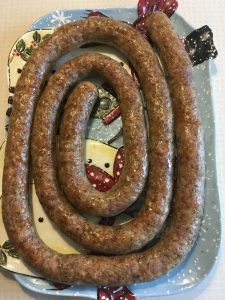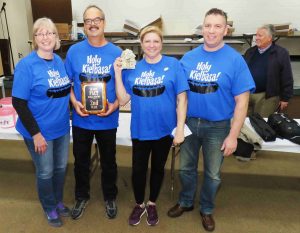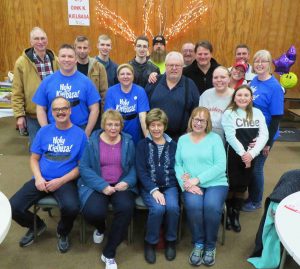
I once attended a competitive Barbeque festival and soon decided that it was mainly geared toward promoting tourism and selling all manner of expensive BBQ paraphernalia. Indeed there is a certain amount of meat preparation knowledge and skill involved with BBQ, but getting a little smoke on tough cuts; then moist-low heat cooking them long enough to become tender, really isn’t very complicated. BBQ competitions normally come down to product presentation (turn-in box display) and whatever flavors are in favor with regional judges. Those reasons are why I never have gotten motivated enough to try my hand at becoming an accredited “pit master.” Conversely, when I learned that there was going to be an amateur fresh sausage making competition 4 hours away from my home, I immediately became very interested. As is true with BBQ competitions, I knew that entering the sausage contest was bound to be a money losing proposition. But, like my little not-for-profit blog site, I view entering it as another personally doable way to try and “give back” to the massive meat processing community.
There exists a good many variables in both the making and cooking of cased sausages. The saying “garbage in, garbage out” was a well founded axiom in the meat further processing arena long before the advent computer programing. So it is, that high quality end products can not be made from low quality starting raw meat, but low eating quality end products are surprisingly easy to make from high quality starting raw product. The pitfalls are many when one tries to batch and masterfully cook an addictive tasting cased sausage. Some starting raw meat variables are: specie(s) of meat animal, age of animals at harvest, what the animals were fed & for how long, fat content, level of fat saturation, color of lean, carcass region that the meat(s) originated from and the amount of bone or other objectionable materials present in starting raw product. After the meat block has been determined, the coarseness of grind for the various meat components has to be decided upon. Coarseness of grind dictates what cooking method is needed in order to most successfully prepare different cased sausages. Maintaining raw meat (and fat components) at a frosty temperature during grinding is an important factor that influences both the eye-appeal and the texture of sausage products. The next big consideration is the virtual universe of non-meat sausage components. Those components can be – added salt for salt-soluble protein extraction and/or flavor, additives for aroma, texture, finished product moisture retention, to inhibit oxidation (warmed-over flavor development), color, to extend product shelf-life etc. Further, batch percentages of every meat and non-meat component (including ice/water must be judged and tested. As should be apparent by now, one does not just wake up one morning and start making great sausage. The totality of all the things involved is what got me excited about the challenge of an amateur sausage making contest.
This competition is Kielbasa making only. But, since the Polish word kielbasa means sausage I thought there might well be a wide variety of flavors and textures offered at the event. So, how can one standout in the sausage making arena? Flavor, aroma, texture, eye-appeal, juiciness, “mouth-feel,” and aftertaste all come to mind.
Some 38 years ago I was given a fresh Polish sausage recipe from my wife’s uncle who lived in Toledo, OH. He and his friend Spud were from the Polish neighborhood there and made sausage together for many years. From the early 80’s on I have continued to occasionally attempt to tweak their fresh Polish sausage recipe. To date, my fresh Polish is often said to be very good. That’s why my wife’s Polish relatives told me about the Toledo contest and encouraged me to participate. I shared that recipe on this blog site a few years back. If you would like to learn from it (Click Here). However, I have since made two process modifications: Using half fine ground black pepper and half coarse ground black pepper. And, grinding half the the lean meat once through a 3/4 inch plate and the other half twice through the same plate. After viewing appetizing online pictures from past year’s Kielbasa competitions in Toledo, I thought it wise to try and “step up” my fresh Kielbasa game. My first thought was to increase the juiciness of the sausage by adding some brisket trim-fat, which is less saturated than most beef fat, to the recipe. However, I eventually decided against that change mainly due to the added expense and inconvenience that would be involved. Further, mixing the flavors of two different meat animal species (fat is thought to be the main carrier of specie specific flavor) might well create a less desirable finished product. I soon thereafter decided upon canned mushroom stems & pieces; in an effort to enhance juiciness, provide some natural umami flavor and to somewhat lessen the sausage’s bind. A small test batch was made incorporating canned mushroom stems & pieces at 7% of the meat batch weight. The mushrooms were ground once through a 3/16″ plate; just ahead of fat. I’m happy to report that all three of the attribute improvements sought after (juiciness, lessened bind and an umami flavor increase) were achieved, but the seasoning level was also decreased with the addition of mushrooms. So, for the competition I’ll be adding 7% mushrooms and increasing spices & herbs 6% (I’m guessing that mushrooms are a little easier to season up than meat). Due to differences in tastes among people, there is no perfect combination of sausage components and cooking practices. All we need to do in order to be successful meat processors is fall somewhere in a range that mainstream consumers will pay for on a repeat basis. Virtually all canned vegetables (I’m including mushrooms in that category) have salt added to them; so I’ll be leaving the batch salt level where it is now. Mushrooms are also a good source of phosphorous, so sodium phosphate will not be increased from where it was prior to adding mushrooms. Additionally, mushrooms are not one of the common 14 food allergens. One other pre-contest change I made was to prick a few holes in the upside of sausage coils (using a traditional sweetcorn cob holder) just prior to cooking and to change the steam-cook from 1 1/2 hours at 225F to 2 hours at 212. Those changes in practice are intended to keep casing from splitting during steam cooking; yet still sufficiently gels the shoulder butt collagen in the coarse ground lean component of the sausage. All my sausage for the competition will be steam precooked, chilled and then cut into 1 inch long pieces (1 inch pieces is called-for by contest rules). At the contest, serving pieces will be browned & heated in electric skillets then dumped into a crockpot set on warm. A little Millard reaction browning is another good finished product enhancement. I’m even going to try and collect fat rendered after steam cooking so it can be used to brown precooked sausage pieces in; on the day of the event.
As I publish this post, the Kielbasa event is still more than a month away. Any constructive input prior to that time will be much appreciated. After the event I’ll revise this post; adding some pictures and explanations as to why I did or did not place in the top 3. And, no I’m not worried about any of my fellow competitors reading this post. It’s a lead-pipe cinch that they all already have their plans in place and therefore will not learn anything new. Besides, I might be attempting to lead them astray.
Pre-contest notes:
Contestants are supposed to bring at least 75 pounds of precooked sausage. There will likely be around a 20% cooking shrinkage, so start out using right around 100 pounds of boneless pork butts. Non-meat ingredients, including water, will push the raw sausage batch weight slightly over 100 pounds. Batch ingredients: 100 pounds of boneless pork shoulder butts, 8) 15 ounce cans of mushroom stems & pieces, 30 TBSP dried leaf marjoram, 15.9 TBSP black pepper (half coarse and half fine ground), 64 cloves of freshly crushed garlic, 9 2/3 cups of cold water, 12 1/2 TBSP sausage sodium phosphate and 31 2/3 TBSP purified flake salt. Marjoram, pepper and garlic will be boiled with most of the water, then chilled the spice blend prior to batch mixing. Remaining water is used to dissolve the sodium phosphate. Salt will be dissolved in the chilled spice mixture just prior to whole batch blending.
Grinding: Well chill all pork and mushrooms. Separate heavy fat and exterior cap muscles from thick shoulder butt lean. Remove all objectionable material while separating pork components. Grind lean component once through a 3/4 inch plate. Then grind half the lean a second time through the 3/4 inch plate. Change to a 3/16 plate and grind mushroom stems & pieces once. Next grind fat and cap meat once through the 3/16 plate. Run two slices of frozen bread behind the fat component to help push some of it out of the grinder head.
Mix everything until batch becomes moderately sticky.
Stuff in 35 – 38 mm natural hog casings. Make gallon plastic bag size coils that are tied off on both ends. Steam-cook as described above; on a rack in a covered oven roasting pan (whole turkey size). Chill somewhat prior to slicing into precooked sample serving sections.

The Kielbasa Cook-Off is over and my team placed second.
I like the big fat pork shoulder butts that Gordon Food Service carries, but since they were only stocking boneless butts that is what I ended up using. There seemed to be less bone fragments in their boneless butts, but I still removed a little over a pound total of objectionable material from 12 butts. After all trimming and fat & lean component separation, I had 106 pounds of starting raw boneless pork. I stayed with the ingredients calculated for a 100 pound meat batch and the finished cooked product turned out to be adequately spiced.
While at GFS (Gordon Food Service) I bought 2 number 10 cans of mushroom stems & pieces. That gave me one extra pound of drained mushrooms; that was used in an onion mushroom sauté for dinner. And, instead of grinding the canned mushroom stems and pieces, as I had said earlier in this post, I chopped them very fine in a food processor then mixed them in with the spice, salt and water mixture.
I went with about 4 pound coils of sausage; that were partially double layered in the gallon zip-lock plastic bags. That increased the weight of the sausage coils to just over 4 pounds; in order to maximize the amount of rope Polish sausage that could be cooked in a large rectangular roasting pan at one time. If I ever do that much sausage cooking at once at home again, I’ll cover 2 half roaster pan halves tightly with foil and slowly steam-cook them both at once. Finish broiling for 10 minutes will take place one pan after the other. Browning one side of the steam-cooked sausage coils adds to finished product eye-appeal and provides for some delicious Millard reaction surface flavor.
In the precooking of sausage, I ended up going 1 hour and 45 minutes at 212F and found that it is not necessary to prick holes in the casings when gently steam-cooking at such a low temperature. As long as the casings don’t split, not pricking keeps more fat and meat juices in the cooked sausage ropes. I also settled on browning one side of coil under the oven broiler, immediately after steam-cooking was completed, for 10 minutes. After every 2 coil cooks I dumped the drippings into a glass bowl and chilled them. Once cold enough the solidified fat from the sausage cooking purge was skimmed off the top and place in bags along with chilled precut sausage. Fat helps seal the exposed cut meat surface of the samples during reheating; plus contributes some additional good pork flavor. As far as a serving, horseradish and warm bread or buns is our family’s go to way. When feeling decadent, I’ll spread horseradish on a slice of baby swiss cheese then wrap it around a length of hot Polish sausage.
In hindsight I wish that I would have pre-steam cooked the Kielbasa just a little longer; until it became more tender. It was thought by me that reheated sausage would be sitting (cooking more) for a time at the event while waiting for takers. But, a much bigger crowd than what was expected showed up and it was all that we could do to keep 160F internal servings stocked in the chafing pans. The coarse ground component of my Kielbasa takes a while to gel up to be good and tender. The upside was that we sold-out 3 hours into the scheduled 5 hour event.
The 1st place winner had a loose textured, old-world style Kielbasa; with a good flavor profile. Their sausage looked to have been ground once through a 3/8 inch hole size plate. I speculate that the raw product had a relatively high fat content and that a long cooking time rendered out a lot of the fat, leaving delicious fat solids behind. The rendering fat also helps cooked lean to retain moisture.


Overall, it turned out to be an enjoyable learning experience; that didn’t cost an unbearable amount of time or money. I will likely compete again next year and would like to see some of my fellow contestants practicing at least a few of the ideas presented in this blog post.
Additional information links:
If you want to know more about the usage of sodium phosphate (Click Here). And, if you want advice on worthwhile home meat processing equipment (Click Here).
